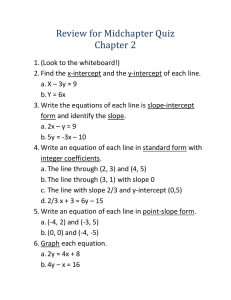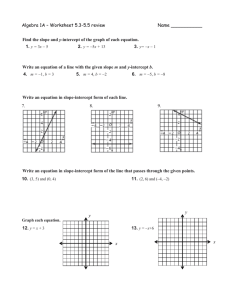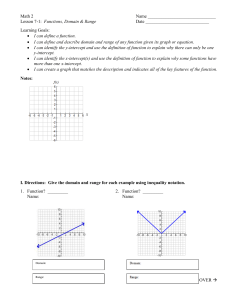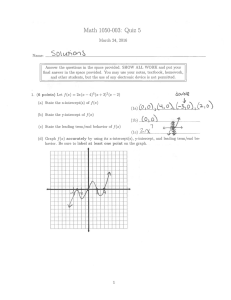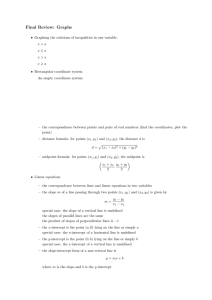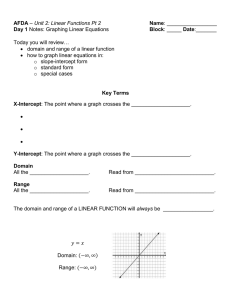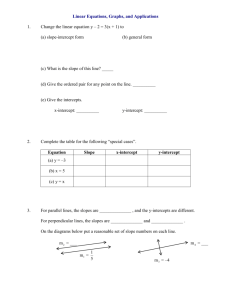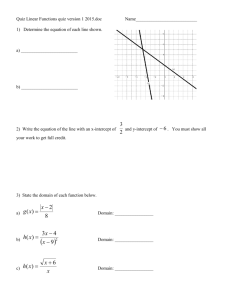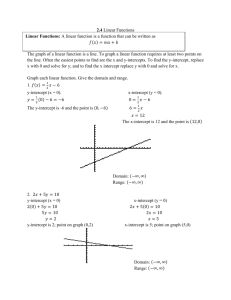Graphs & Algebra of Functions: Linear & Nonlinear Examples
advertisement
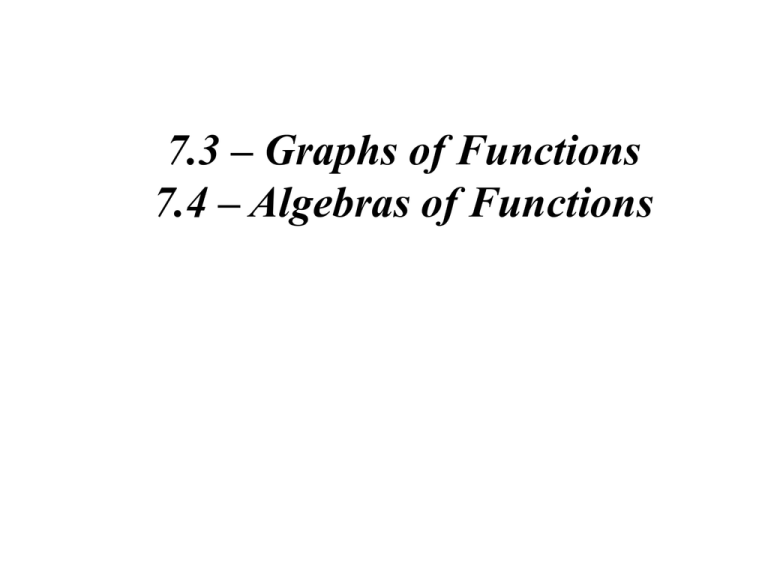
7.3 – Graphs of Functions
7.4 – Algebras of Functions
Equations of Lines
Standard form:
Ax + By = C
Slope-intercept form: y = mx + b
Point-slope form:
y y1 = m(x x1)
Example
Graph 5x + 2y = 10.
Solution
Let x = 0 to find the y-intercept:
5 • 0 + 2y = 10
2y = 10
y=5
The y-intercept is (0, 5).
Let y = 0 to find the x-intercept:
5x + 2• 0 = 10
5x = 10
x=2
The x-intercept is (2, 0).
y-intercept (0, 5)
x-intercept (2, 0)
5x + 2y = 10
Example
Graph: 3x + 4y = 12
Solution
Rewrite the equation in slope-intercept form.
3 x 4 y 12
4 y 3x 12
1
y 3 x 12
4
3
y x3
4
Solution
The slope is 3/4 and the
y-intercept is (0, 3).
We plot (0, 3), then move
down 3 units and to the
right 4 units.
An alternate approach
would be to move up 3
units and to the left 4 units.
left 4
(4, 6)
up 3
(0, 3)
down 3
right 4 (4, 0)
Linear Function
A function described by an equation of the
form f(x) = mx + b is a linear function. Its
graph is a straight line with slope m and
y-intercept at (0, b).
When m = 0, the function is described by
f(x) = b is called a constant function. Its graph
is a horizontal line through (0, b).
Example
4
Graph: f ( x) x 2
3
Solution
The slope is 4/3 and the
y-intercept is (0, 2).
We plot (0, 2), then move up
4 units and to the right 3 units.
We could also move down
4 units and to the left 3 units.
Then draw the line.
right 3
(3, 2)
up 4 units
(0, 2)
y
down 4
(3, 6)
left 3
4
x2
3
Example
Graph y = 2
Solution
This is a constant function. For every input x, the output is 2.
The graph is a horizontal line.
y=2
(0, 2)
(4, 2)
(4, 2)
Nonlinear Functions
• A function for which the graph is not a
straight line is a nonlinear function.
Type of function
Example
Absolute-value
f(x) = |x + 2|
Polynomial
p(x) = x4 + 3x2 – 2
Quadratic
h(x) = x2 – 4x + 2
Rational
r ( x)
x3
x4
Example
Graph the function given by g(x) = |x + 2|.
Solution
Calculate function values for several choices of x and
list the results in a table.
x
g(x) = |x + 2| (x, f(x))
1
3
(1, 3)
2
4
(2, 4)
–1
1
(–1, 1)
–2
0
(–2, 0)
–3
1
(–3, 1)
0
2
(0, 2)
The Algebra of Functions
If f and g are functions and x is in the
domain of both functions, then:
1. ( f
2. ( f
3. ( f
4. ( f
g )( x) f ( x) g ( x);
g )( x) f ( x) g ( x);
g )( x) f ( x) g ( x);
g )( x) f ( x) g ( x), provided g ( x) 0.
Example
For f ( x) 2 x x and g ( x) 3x 1,
find the following.
a) ( f + g)(4)
b) ( f – g)(x)
2
c) ( f /g)(x)
d) ( f g )(1)
Solution
a) Since f (4) = –8 and g(4) = 13, we have
( f + g)(4) = f (4) + g(4) = –8 + 13 = 5.
Solution
b) We have, ( f g )( x) f ( x) g ( x)
2 x x (3x 1)
2
x x 1.
2
c) We have, ( f / g )( x) f ( x) / g ( x)
2x x
.
3x 1
2
1
x
3
d) Since f (–1) = –3 and g(–1) = –2, we have
( f g )(1) f (1) g (1) (3)(2) 6.
Example
1
Given f ( x)
and g ( x) x 2,
x 1
find the domains of
( f g )( x), ( f g )( x),( f g )( x) and ( f / g )( x).
Solution
Domain of f + g, f – g, and
f g is {x | x 1}.
Solution continued
To find the domain of f /g, note that
f ( x) 1/( x 1)
( f / g )( x)
g ( x)
x2
can not be evaluated if x + 1 = 0 or x – 2 = 0.
Thus the domain of f /g is
{x | x 1 and x 2}.
Examples
•
Find the following
a. (f+g)(x) b. (f – g)(x) c. (fg)(x) d. (f/g)(0)
1)
2)
3)
•
f ( x) 2 x 5
g ( x) 1 x
x2
f ( x) | x 3 | g ( x) 2
x 1
x
f ( x)
g ( x) x 3
x 1
Evaluate when f(x) = x² + 1 and g(x) = x - 4
1) ( f g )(1)
f
2) (0)
g
3) ( fg )(3t 2 )
Group Exercise
For the functions
a.
b.
c.
d.
e.
f.
g.
(f+g)(x)
(f – g)(x)
(fg)(x)
(f/g)(0)
(f+g)(-1)
(fg)(0)
(f/g)(1)
f ( x) 2 x 2 5 x 3
g ( x) 1 x 2

